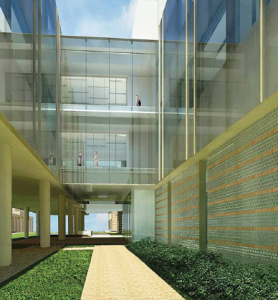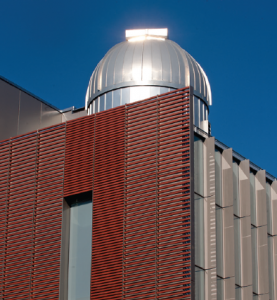

Opened in 2011, Brockman Hall for Physics is thoughtfully designed to support research and education in fundamental and applied physics. This four-story, 111,000-square-foot, state-of-the-art facility houses laboratories, faculty and student offices, meeting spaces, a 150-seat lecture hall, and a rooftop astronomical observatory.
Centrally Located
Centrally located in the Natural Sciences Quadrangle, the facility brings together faculty and students who formerly worked in five separate buildings scattered broadly across the campus. Research supported in this facility encompasses atomic, molecular, and optical physics; biophysics; condensed matter physics; nanoengineering; and photonics. Brockman also houses a state-of-the-art electron microscopy facility. Thus, as noted by Rice University President David Leebron, “The impact of Brockman Hall goes beyond bricks and mortar.” Indeed, it “forges new pathways between science and engineering, between theory and practice, and between Rice’s first and second centuries.”
State-of-the-art design
The building contains vibration-and-temperature-controlled research laboratories and state-of-the-art facilities to meet the exacting requirements of modern physics. Indeed, to minimize vibrational interference, the laboratories are located in the basement of the building atop a 2-foot-deep slab that absorbs ground-borne vibrations. Each laboratory has precise temperature, humidity, and airflow control to support the operation of ultra-precise and ultra-sensitive equipment. Electrical isolation prevents experiments being conducted in one laboratory from impacting those being conducted in another. Moreover, state-of-the-art equipment supplies these labs with “clean” electrical power, as well as chilled water and filtered air that is cleansed of submicroscopic dust.
Environmentally sustainable
Brockman Hall for Physics is one of the most environmentally sustainable buildings at Rice; the building meets the U.S. Green Building Council’s standards for Leadership in Energy and Environmental Design (LEED) Silver standards, and is expected to content for LEED Gold status. Energy-saving and environmental features of the building include an energy-recovery system – the largest in a single air unit in Texas – that will save as much as 30 percent of the energy needed to cool the building in the summer. Another green innovation is the building’s de-humidification system, which turns Houston’s legendary humidity into an asset by capturing and returning 100,000 gallons of pure, clean water to Rice’s central plant each year.
Funding
Funding for the construction of the building was provided through a generous gift donated to Rice University’s Centennial Campaign from the A. Eugene Brockman Charitable Trust, as well as from $11.1 million in federal stimulus funding from the National Institute of Standards and Technology (NIST).
Sources: Jade Boyd, “Rice dedicates state-of-the-art physics research facility,” March 25, 2011, Rice News. http://news.rice.edu/2011/03/25/rice-dedicates-state-of-the-art-physics-....
Last updated: February 2020.
